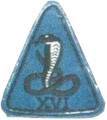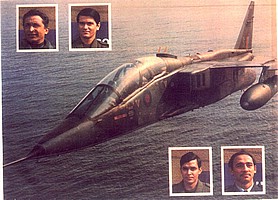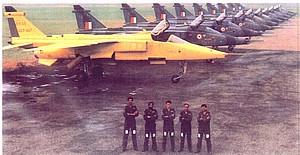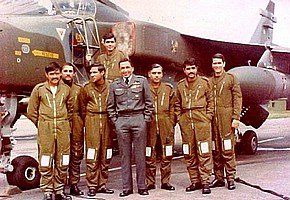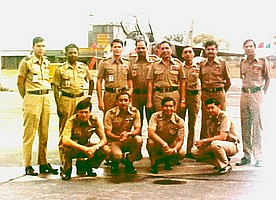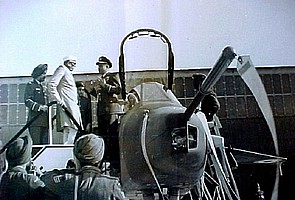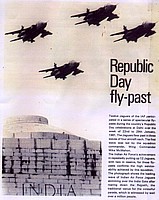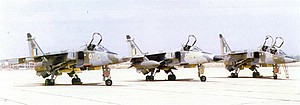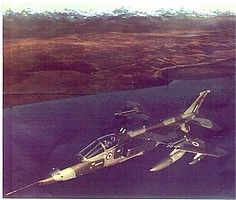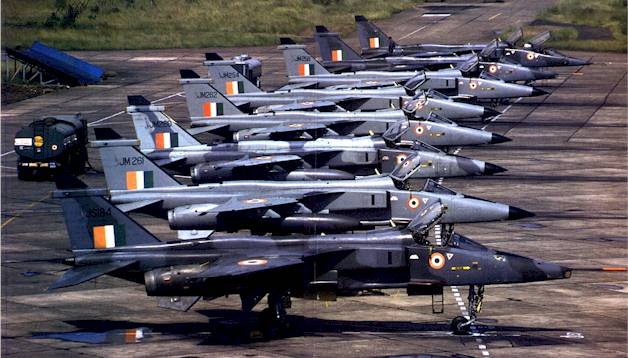
A line up of eight Jaguars belonging to No.6 Squadron at Lohegaon AFS in October 2001. Nearest is a Jaguar IS, followed by Jaguar IM Maritime Strike versions with the Agave Radar. A two seater IB is at the far end of the line. Photo Courtesy : Alan Warnes / AirForces Monthly.
Twenty-five years ago, on July 27 1979 the first two Jaguar aircraft landed in India. It was the beginning of a new era in the aviation capabilities of the Indian Air Force (IAF). Vampires from De Havilland, first introduced in India in 1948, had retired. Canberra B(I)58 and Hawker Hunter F.56 both aircraft types of 1957 vintage were getting outdated. India needed a modern aircraft for low-level interdiction and close air support. The selection of an aircraft styled by IAF as the Deep Penetration Strike Aircraft (DPSA) was full of drama and conflict of vested interests. Victory for the Jaguar did not come easily.
Development of the Jaguar
The Royal Air Force (RAF) was feeling the aftereffects of Britain’s Secretary for Defence Duncan Sandys’ “The Way Forward”, a 1957 paper that aimed to provide the UK with affordable defence. Sandys view was that conventional warfare was outdated and that future wars would be fought with nuclear weapons. But RAF continued to search vigorously for a trainer and also a low-level strike fighter-bomber for interdiction and reconnaissance. By the late 1950s, these became critical requirements. France also came to realise the need of similar aircraft.
RAF’s plans for a twin-engine trainer aircraft proved to be rather costly. Instead of it, concurrent perception by Britain and France of the need for an aircraft to meet almost identical requirements led to a natural collaboration for developing the new fighter-bomber. The aircraft was named the Jaguar. The first Jaguar prototype made its maiden flight at Istres (France) on September 8, 1968. British Aircraft Corporation (BAC) and Breguet Aviation formed an Anglo-French company for design, development, production and marketing of the Jaguar. The company was given the unwieldy name SEPECAT (Société européenne de production de l’avion d’école de combat and d’appui tactique). Dassault acquired Breguet Aviation in 1967 and became party to the project. While the collaborative effort began well, it diverged into different directions with components and equipment being used which were not common to both countries.
The HF-24: First Competitor of Jaguar
Meanwhile, India had the ambition to meet the DPSA requirement indigenously. The first prototype of the Hf-24 designed by Kurt W Tank (of Focke Wolf 190 fame) and his fifteen-man German team made its first flight in July 1961. But the aircraft did not have suitable engines. It was designed around the Orpheus-12 without India having tied up a contract for it with Bristol Siddeley.
Bristol Siddeley, knowing its strong position, tried to extract the full development cost of the Orpheus-12 from India. It was rumoured that similar demands, without distributing costs between possible customers, were made to Italy and Sweden. In the event, the engine was not acquired by anyone and its development ceased. This was a major blow to Indian ambitions of developing the HF-24 to its expected potential. The HF-24 entered IAF service in 1965 still underpowered by two Orpheus-703 engines.
However, its safety record was the best of all fighter aircraft in IAF service till then. On at least three occasions the HF-24 was flown back to base after losing one engine. The first was in the 1971 War over Pak territory during ground attack when one engine broke up after ingesting debris from the attack site. A kite hawk hit the innards of the left engine of another HF-24. The engine shattered and a three feet by three feet square gap opened up on its side. The aircraft was then over Udaipur. It flew back to its base in Jodhpur 157 nautical miles away on the other engine and landed safely. Incidents like this convinced the IAF that a two-engine aircraft would be ideal for the DPSA role.
A search for alternative engines for the Marut began. With the help of Rolls Royce and Dowty, the Gas Turbine Research Establishment modified the Orpheus 701 for reheat. These engines were being produced in India for the Gnat. The HF-24 Mk1A with two reheat capable engines was flown and soon an aircraft designated HF-24 Mk1R began its trials. It was intended to match the Jaguar in most respects. Unfortunately, the rear fuselage had simply been enlarged to accommodate the larger diameter engines. This raised its after-body drag to very high levels. A similar airframe of HF-24 was loaned and later presented to Egypt for installation of the E-300 engine under development for HA-300 light fighter designed by Willy Messerschmitt. The misconception in India was that the E-300 could be used to power the HF-24 and the aircraft used by both countries. Since the Egyptians had no interest in the HF-24, no real collaboration was possible and India pulled out of the project. This spelt the death-knell of the HA-300 and of India using the E-300 for the HF-24.
IAF’s Eye on Jaguar
The IAF watched the early development of the Jaguar with keen interest but with no real inclination to acquire it. The keenness was to see how its own HF-24 would do the job so that import or licence production of an aircraft would not be needed.
After the Chief Test Pilot of Hindustan Aeronautics Ltd (HAL) was killed in the HF-24 Mk1R prototype in January 1970, it became clear that the HF-24 would not meet the requirements of a DPSA. The project to power the aircraft with engines with reheat was abandoned. Nevertheless, the HF-24 performed creditably in the 1971 War with Pakistan in the Western Sector. The HF-24, renamed Marut, had other shortcomings apart from lack of power. It had no avionics worth the name. It ceased to be a viable competitor to the Jaguar, which became the first on IAF’s wanted list after being held back by the HF-24 for almost seven years.
Early offers of Jaguar to IAF
In mid-1968, even before the maiden flight of the aircraft, SEPECAT made the first formal offer of the Jaguar to India. Jeffrey Quill and Paul Jaillard as a two-man team made a presentation of the aircraft to IAF and invited India to become its launch customer. The Jaguar was offered at an amazingly low cost. This was unacceptable to IAF after its unpleasant experience as the first and only customer for the largely under-developed Folland Gnat, which recorded the highest accident rate of all jet fighters of IAF including the MiG-21 series.
With this in mind and in the hope of developing the HF-24Mk IR, IAF was hardly interested in the aircraft. Two years later, Jeffrey Quill with Jimmy Dell (Deputy Chief Test Pilot of BAC) again made a presentation, this time at Delhi’s Vigyan Bhawan (Science Hall). This was well attended, among others by the Chief of Air Staff and a number of Air Marshals. But the lack of interest of the IAF came through when at the end of the presentation no senior officer asked a single question. Later, there was perhaps more interest in quizzing Jeffrey Quill for his work in developing the Spitfire than asking anything about the Jaguar.
IAF was aware that the Jaguar was having difficulty in overshooting on a single engine with reheat. Dry power was not enough and reheat power was excessive. Modulated reheat, later officially named Part Throttle Reheat (PTR), was being developed. It is believed that the visitors were told that India had no interest in the Jaguar but would have liked to use its engines for the HF-24. Since the Adour 102 engine was having difficulties of its own in developing the reheat system, it could not be considered for the HF-24. The disappointed team returned to Europe.
European Competitors & IAF’s Decision
India’s large requirement of aircraft caught the attention of competitors. Dassault-Breguet offered the Mirage F-1, a single engine fighter aircraft with some ground attack capabilities. Sweden’s Svenska Aeroplan Aktiebolaget came in with its SAAB 37 Viggen, also a single engine aircraft powered by a Swedish supersonic development of the Pratt & Whitney JT8D by-pass engine with a Swedish afterburner and thrust reversal.
As is common in India, many interested parties including agents, other promoters and even politicians got into the act of promoting the aircraft, which would give them the most personal benefit. However, IAF was clear in its stand of wanting only a two engine aircraft. Another complication was that after the 1965 Indo-Pak war, USA and Britain had placed embargoes on supply of military equipment to India. India always had a problem with USA’s penchant for imposing sanctions for all kinds of reasons. Since the Viggen’s engine was essentially of US origin, it would have been instantly disqualified but for political influence. The possibility of denial of equipment or spares from Britain was also a major hitch. Mr James Callaghan, the Prime Minister personally solved this problem. On his way back from Australia he gave an unequivocal commitment that Britain would never impose any sanctions on India in future.
After the imposition of a National Emergency, Mrs Gandhi had been ousted when elections took place. The Janata Dal Government decided to pursue the DPSA acquisition vigorously. Meanwhile, British Aerospace (BAe) was formed as a corporation in April 1977 by the merger of the BAC, Hawker Siddeley Aviation, Hawker Siddeley Dynamics and Scottish Aviation. In March 1978, an Indian team led by the Defence Secretary visited France, Sweden and England. After receiving its report, the Government decided to ignore the other two aircraft and to enter into a contract with BAe to acquire the Jaguar. A formal announcement of the selection of the Jaguar to meet DPSA requirements was made by the Government on October 6 1978. By then BAe’s Wg Cdr Alan Keys (RAF Retd) had visited India 24 times to promote the Jaguar.
|
Units operating the SEPECAT Jaguar in the Indian Air Force |
||||
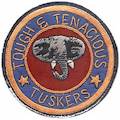 |
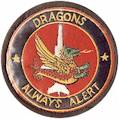 |
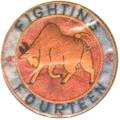 |
|
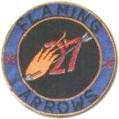 |
Mutually Beneficial Agreements
The memorandum of intention to proceed was followed in April 1979, almost seven months later, by formal contracts for purchase of around 130 aircraft, licence production and transfer of technology. BAe was to provide a batch of 35 Jaguars as Direct Supply (DS). These were to be manufactured at Warton Lancashire. with some parts coming from France. This gave considerable amount of work to BAC and generated or sustained significant employment. Following this, Hindustan Aeronautics Ltd (HAL) was to begin producing aircraft at Bangalore. In the meantime full-scale activity began. The RAF through BAe offered to loan eighteen aircraft including two trainers to IAF so that pilot familiarisation and training of engineers and airmen could begin. The RAF also offered training of twelve pilots, engineers and airmen in its own units and squadrons. The IAF could hardly refuse this very welcome offer, not matched by Dassault-Breguet or SAAB. BAe was getting good business while IAF was being facilitated for early induction of Jaguars. Twenty-five years later a similar pattern has been followed to help IAF acquire the Hawk as its Advanced Jet Trainer from BAE SYSTEMS, the new form of BAe after merger with GEC-Marconi in January 1999. Though no aircraft are being loaned to IAF, 75 of its pilots are to be trained by RAF in the UK.
Training in the UK
Wing Commander DR (Natty) Nadkarni (now a retired Air Marshal) was picked to command No. 14 Squadron, which was to be the first Jaguar unit. The Wg Cdr arrived in London on February 26 1979 with three other experienced pilots. As the Squadron Diary records, the days in London were spent pub-crawling and surviving on Wimpy’s Burgers. This mini-holiday was too good to last. Just before their allowances ran out, the four pilots reported to RAF for conversion to Jaguar aircraft. But first they had to undergo medical check-ups and orientation. Sea-survival training followed this. As Squadron Leader M (Mike) McMahon (Air Marshal now retired , from the post of VCAS) remembers,
“Before we started flying training, we did a Sea Survival Course at Plymouth. In February, water temperatures were teeth chattering. The ‘actual’ training took place in the English Channel, not a friendly swimming pool! I remember that the shock of hitting the chilly water was so great that I opened my mouth and promptly swallowed half the Channel! My fingers were numb for days thereafter”.
All the chilled Indian pilots shared this opinion.
The Conversion training that followed at Lossiemouth was excellent. Unlike Russia where ground training was always overly detailed, the RAF trained them on a need to know basis and expected the pilots to research further themselves. The format for training at No. 226 OCU was similar to that for RAF’s own Jaguar pilots. But the syllabus was abridged to 45 hrs flying training at Lossiemouth and 25 hrs more for the first batch at RAF Coltishall with No 54 and No 6 Squadrons. In addition Squadron Leaders SP (Bundle) Tyagi and DDS (Dee Dee) Kumar did a photo-reconnaissance course at Coltishall with No 41 Squadron. As is common in the UK, they flew in all kinds of weather, which later made IAF dignitaries visiting BAe Warton raise their eyebrows! The other two batches of four pilots followed suit in April and August 79, taking around four months each for the training by RAF.
Averted hitch in acquiring Jaguars
When Mrs Indira Gandhi came back to power in 1980, her younger son Sanjay decided to scrutinise the Jaguar deal for suspected corruption. He was convinced that Viggen was the superior aircraft and that IAF had been influenced by the previous Government to opt for the Jaguar. He had no constitutional authority, except for his parentage. Nevertheless, he was invited by the IAF to examine its files. He was surprised to find that the IAF had throughout been steadfast in its intention to buy the Jaguar. The other two aircraft had been considered only for giving the semblance of multiple choices available to negotiators. Sanjay Gandhi was killed in a flying accident on June 23, 1980. No further doubts were ever raised on the wisdom of inducting Jaguars into the IAF.
Ferry of Jaguars to India
The first two aircraft, one trainer and one solo fighter, to be brought to India were ferried by BAe’s test pilots. Wg Cdr Nadkarni flew in the trainer. Starting from Warton, with stopovers at Toulouse (France), Brindisi (Italy), Luqa (Malta), Akrotiri (Cyprus), Seeb (Oman), the aircraft arrived in Jamnagar (India) on July 27 1979, just three months after the actual signing of the contract. The journey had taken them one week. The pair arrived in Ambala on July 29. Except for one more aircraft flown by a BAe test pilot, all loaned aircraft and later the 35 direct supply aircraft were ferried to India by IAF pilots. Natty Nadkarni says that during the ferry, they were shadowed by F-14A Tomcat aircraft of the US Navy. The Tomcats were operating from the carrier USS Kitty Hawk. The American pilots took pictures of the Jaguars while the Indians merely looked back at them. The Americans may have been investigating what the aircraft types were, where they were heading and also ensuring that they did not fly over their carrier.
In February 1980 four Jaguars piloted by IAF crew routed via Baghdad en route Jamnagar. But this route had to be abandoned after war broke out between Iraq and Iran. Thereafter aircraft flew via Luxor in Egypt. During almost all the ferries, the F-14s kept an eye of IAF aircraft flying bye. All DS aircraft were brought to India without a hitch.
The Avionics Imbroglio
A major attraction of Jaguar had been its avionics suite, though similar equipment was available in the other two contenders as well. RAF’s Jaguars were fitted with the NAVWASS (NAVigation Attack Weapon Aiming Sub-System) from Marconi-Elliot Avionics Systems Ltd, with a Head-Up display from Smiths. RAF had let India know that the Marconi equipment had very low reliability to the extent that during operations no aircraft could be expected on the flight line after just six (or so) sorties each. In 1975 Aircraft & Systems Testing Establishment (ASTE) in Bangalore had tested the full NAVWASS on an HF-24 and rejected it. But the NAVWASS was standard equipment on the loaned Jaguars and there was no quick way to replace it on the DS aircraft. The RAF wanted to upgrade the Inertial Navigation System (INS) with the Ferranti FIN 1024 INS and share development costs with IAF. But the IAF was offered its export version FIN 1024E. The catch was in the E, which meant that the gyros used in the system were inferior to those for the RAF. This led India to consider an upgrade on its own as early as possible.
The DARIN Story
The original name suggested for the project for upgrading the navigation attack system of Jaguars was INDRA, after the king of the minor Hindu gods. But this was uncomfortably close to the name of the PM Mrs Indira Gandhi. The CAS Air Chief Marshal Dilbagh Singh altered it to DARIN which stands for Display Attack Ranging Inertial Navigation. To manage the project, Inertial Nav-Attack System Integration Organisation (IIO) was specially set up at Bangalore under the aegis of Defence R&D Organisation (DRDO).
With IIO as the project office, Sagem (France) was designated Prime Integrator and HAL the prime agency for work on the aircraft. Specifications for various equipment and interface documents were drawn up at IIO. The task of selecting the equipment to be integrated as a Nav-Attack system was completed quickly by IIO in consultation with ASTE which already had the experience of flight trials on Inertial Navigation Systems (INS) and Head Up Displays (HUD). The major subsystems selected were Sagem Inertial Platform, Smiths Industries HUD/WAC, Ferranti Combined Map & Electronics Display (COMED), Crouzet Air Data Package and SFIM Flight Test Instrumentation Package – all to be integrated using dual Mil 1553B standard Digital Databus. The Sagem ULISS 82 box handled primary Navigation and weapon aiming functions, with Smiths HUD/WAC computer taking over if the ULISS failed. Target range was provided by Jaguar’s original equipment, the Ferranti Laser Ranger and Marked Target Seeker. Ranges derived from radio and barometric altimeters were used in the secondary and tertiary modes.
British Aerospace was the official “Design Authority” for Jaguar and was therefore involved throughout with the project. For the modifications in India, BAe vetted draft specifications, installation drawings, ground and flight test schedules, electro-magnetic compatibility and test results, etc. Line Replaceable Units (LRUs) were first cleared by vendors and then moved to a static integration rig at Pontoise by Sagem. After about a year the integration rig and models of LRUs were transferred to IIO at Bangalore. This rig played an active part in integrating flight-worthy models and troubleshooting during subsequent phases.
Direct Supply aircraft JS-102 & 103 were ferried & delivered to IIO in 1981 for modification and trials. Items to be rendered redundant by the upgrade were removed by HAL. The new Smiths HUD gave trouble in installation due to its volume. Its high-tension unit was shifted to the avionics bay. COMED display installation also posed problems of access for removal and replacement. Avionics bay cooling was redesigned to ensure adequacy for additional equipment to be installed later, such as ECM, radar etc.
On successful completion of all the modifications, the first flight took place at Bangalore on 17 Dec 1982. ASTE’s test pilots flew the aircraft for all phases. Navigation accuracy of the modified system was better than one nautical mile per hour called for in the specs. Weapon aiming accuracy trials were carried out at Indian Space Research Organisation’s Sri Harikota Air Range (SHAR) near Chennai. Photogrammetry was used to validate software solutions. The associated computer programmes were transported successfully. Film recording of pilot’s HUD display along with Radio Release Tone (RRT) provided the correlation with aircraft position determined by theodolites. Finally, live weapons were dropped at the desert range in Rajasthan. Initial Operational Clearance (IOC) was accorded in 1984 and Full Operational Clearance (FOC) a year later. The system now caters for manual or automatic release of a range of weapons. The pilot has the freedom of a wide release envelope from steep dives to toss bombing within a large speed margin. The reliability of the DARIN proved to be ten times better than the old system and was well received by the IAF. IIO also modified six Jaguars with Thomson CSF Agave radar and DARIN system for maritime patrolling. These were enabled to use the Sea Eagle missiles
Second Avionics Upgrade: DARIN II
To extend the operational life of Jaguars by perhaps another two decades, further improvement of avionics suite is now in progress under project DARIN II. This involves a Sagem Ring-Laser-Gyro INS with integrated Global Positioning System (GPS). The combination is yielding a position accuracy within 100 metres, which does not degrade with flight time. Twin mission computers developed by DRDO’s Defence Avionics Research Establishment (DARE) are installed, providing much better redundancy than in the original DARIN refit.
An Israeli HUD from Elbit replaces the Smiths’ one and an indigenous Rear Warning Radar the original Marconi’s. The COMED has been abandoned, its task now being done by Smart Multi-function Displays (SMDs). An imported chaff dispenser has been added. On the ten maritime Jaguars the Agave radar is to be replaced by one from Israeli Elta Systems Group. Currently DARIN II upgrade is in progress on the 17 two seat Jaguars being produced by HAL. At least eight of these have already been delivered to IAF. In time DARIN II will first replace the NAVWASS on all direct supply strike Jaguars during their overhaul at HAL. An autopilot is currently under development in the country. Later DARIN II upgrade including the autopilot may be implemented on all remaining aircraft in service.
Jaguars in service with IAF
The batch of pilots trained in the UK had included qualified flying instructors (QFIs). No.14 Squadron was declared operational in September 1980. After the 35 DS Jaguars, including five trainers, arrived in India, IAF pilots returned the loaned aircraft to UK. However, two of these had been lost in accidents. The new Jaguars re-equipped No 14 Sqn whose QFIs converted more pilots to Jaguars. The second Jaguar Squadron No 5 became operational in August 1981. The Jaguar was named Shamsher in IAF which in Persian means the “Sword of Justice”. At ASTE the over-wing missile rails were used to install and clear MATRA R550 Magic short-range infrared-homing air-to-air missiles for self-defence.
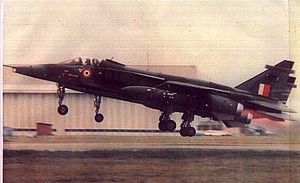 |
A pair of Jaguars taking off. The second Jaguar is mostly obscured, but the undercarraige can be seen clearly. |
| A formation of six Jaguars. | 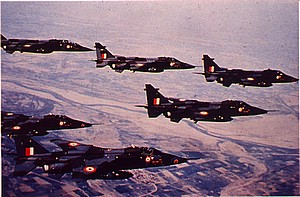 |
Aircraft were initially manufactured at HAL from knocked-down kits and then with most components being manufactured in-house. These were fitted with the more powerful 8,400-lb static thrust Adour Mk 811 engines instead of the Adour 804E used on the direct supply aircraft. The DARIN upgrade was implemented on all of them. This allowed the fitment and use of a wide range of new weapons and systems. Eventually five IAF Squadrons were equipped with Jaguars viz. Nos. 14 (Bulls), 5 (Tuskers), 16 (Black Cobras), 6 (Dragons) and 27 (Flaming Arrows). All squadrons except No. 6 have the common role of low-level strike and reconnaissance. “A Flight” of No. 6 Squadron was the last to re-equip. In 1991 it traded in its Canberra fleet for the maritime Jaguars to meet its primary role of guarding the seas around India. The B Flight has the normal strike Jaguars. Since flying in No. 6 Squadron requires greater skills, it has a considerable training role. Many of the new DARIN II equipped two seat Jaguars may be allotted to the unit to meet the training requirements.
|
Allocation of Jaguar Serials |
|
| JI001-JI018 | RAF aircraft on loan – returned (18) |
| JS101-JS135 | UK Direct Supply (35) |
| JS136-JS204 | HAL Manufacture (79) |
| JT051-JT053 | UK Direct Supply Two seaters (3) |
| JT054-JT065 | HAL Manufactured (12) |
| JT066-JT082 | HAL Manufactured DARIN II (17) |
| JM251-JM262 | HAL Manufactured Maritime (12) |
| Total | 158 + 18* (* – Loan / Returned) |
HAL has so far produced close to 100 Jaguars. Of the 17 Jaguar trainers, all equipped to DARIN II standard, 8 aircraft have been delivered to IAF. The remaining 9 will be produced within this financial year. In 25 years of its service IAF may have lost over 35 Jaguar aircraft. A DS aircraft was the first to be lost due to bird hit on one engine. Unlike the HF-24, the break up of the engine damaged the other engine as well forcing the pilot to bail out. Losses have been due to bird hits, pilot error, engine failures after debris ingestion and disorientation at night. Unconfirmed press reports indicate that IAF may order twenty more strike fighters.
Flying the Jaguar
Pilots of IAF have been very pleased with the flying characteristics and avionics fit of the aircraft. For many pilots, the Jaguar was a very welcome introduction to modern avionics – even the DS aircraft with the NAVWASS installed. Weapon delivery results for most pilots improved with this aircraft. Perhaps its most admired feature is the Part Throttle Reheat which allows selection of power all the way from dry idling to maximum reheat. The aircraft gives a smooth ride even in hot summers at low altitude. This is achieved despite strong thermals and the Jaguar flies better in these adverse conditions than any other IAF aircraft type. The only criticism against the aircraft is the lack of power at high altitude where flying is meant only for transit. This is the natural result of using a bypass engine for fuel economy to meet its designed low-level strike role. The general opinion is that the acquisition of Jaguars has been a very wise move which enhances the operational capabilities of IAF very considerably.
| A Jaguar of the Tuskers carrying Eight 1000lb Retarder bombs. The bomb load is more than the typical load of a 50s vintage Canberra bomber! | 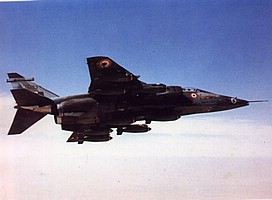 |
Operational Use of Jaguars
Jaguars saw some minor action with the Indian Peace Keeping Force (1987-1990), which had been sent to Sri Lanka to help resolve the issue of Tamil separatists. Aircraft flew out from the southern part of India, carried out reconnaissance and returned to base. They never had to fire any weapons. During the 1999 Kargil operations, Jaguars were used to drop conventional weapons to dislodge so called insurgents and Pak military groups. The aircraft also dropped one Laser-Guided-Bomb (LGB), which was not very successful. Thereafter Mirage 2000 aircraft handled this task. Later, Jaguars were on constant standby when India massed its forces on the Pak border in a show of strength and displeasure at militant activity encouraged by Pakistan. The aircraft must have been employed for reconnaissance but within Indian borders.
Hopefully, Jaguars will not need to be used in anger in the near future. But to further hone operational skills, six aircraft left in end-June for ‘Cope Thunder 2004’ multinational exercise in Alaska. For this exciting ferry there and back, the Jaguars refuelled in flight from IAF’s newly acquired Il-76 tankers. The latter also supported the aircraft with spares and ground crew for the ferry and the exercise. The aircraft returned safely to India having acquitted themselves well in the exercise.
Quarter Century of Jaguars in India
The silver jubilee of Jaguars operating in India was celebrated at Ambala on September 11, 2004. This was delayed a bit to allow the return of the Jaguars from Alaska. Most of the early stalwarts who had converted to the aircraft in UK, commanders at various levels, pilots and engineers attended the revelry. This was a first for IAF. Many aircraft completed more than25 years in IAF service without anyone bothering to notice it, such as Hunters and Canberras. IAF is perhaps still flying a few of the latter after 47 years since induction. India’s first indigenous aircraft, the HT-2 was in service for more than thirty years. Kiran trainers have exceeded this already and have yet to go some way. The Avro 748 has been in IAF for more than 40 years.
Hopefully the tradition to observe such milestones will now be a more regular feature. Pilots, engineers and technicians all get to love the aircraft they fly or work on. It is a very sentimental moment when you need to say goodbye to them. A formal farewell is perhaps the finest way to let the aircraft retire gracefully.
This article was previously published in AirForces Monthly and Indian Aviation Magazine
